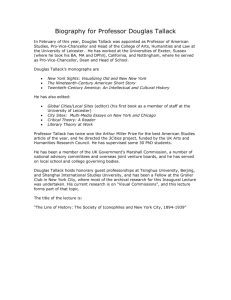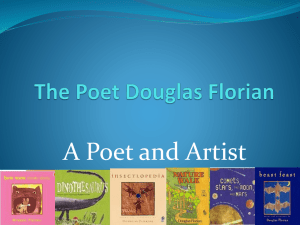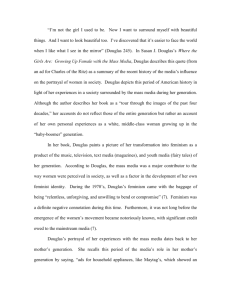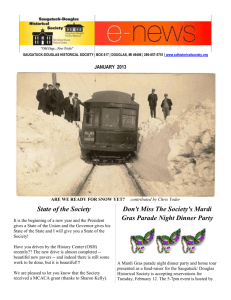Emory Douglas, Black Panther artist & more
advertisement
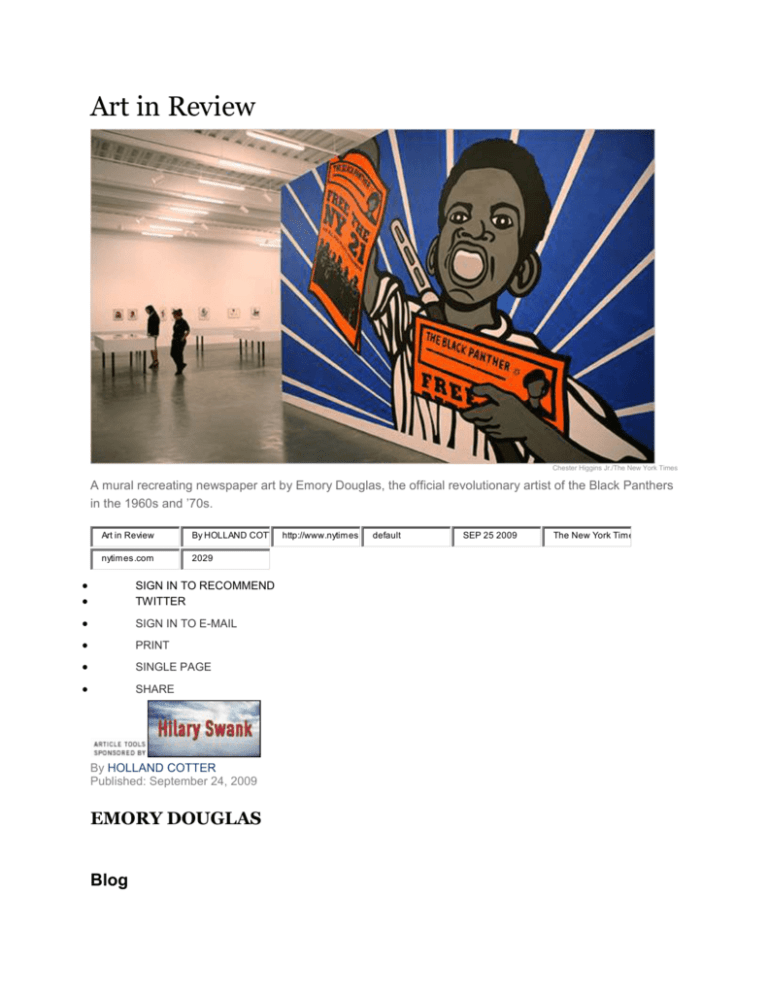
Art in Review Chester Higgins Jr./The New York Times A mural recreating newspaper art by Emory Douglas, the official revolutionary artist of the Black Panthers in the 1960s and ’70s. Art in Review By HOLLAND COTT http://www.nytimes nytimes.com 2029 SIGN IN TO RECOMMEND TWITTER SIGN IN TO E-MAIL PRINT SINGLE PAGE SHARE By HOLLAND COTTER Published: September 24, 2009 EMORY DOUGLAS Blog default SEP 25 2009 The New York Time ArtsBeat The latest on the arts, coverage of live events, critical reviews, multimedia extravaganzas and much more. Join the discussion. More Arts News ‘Black Panther’ The New Museum 235 Bowery, at Prince Street Lower East Side Through Oct. 18 James Baldwin wrote that “artists are here to disturb the peace.” He might have added that the artist’s job is also to create peace in the midst of disturbance. Both sides of the picture apply to the work of Emory Douglas, who from the late 1960s to the late ’70s was minister of culture in the Black Panther Party and its official revolutionary artist. In these roles, he not only designed and illustrated the party’s weekly newspaper but also created a wide range of political posters, broadsides and promotional cards in a vigorously resourceful, eye-zapping graphic style. In 2007 a younger California artist-activist, Sam Durant, organized a survey of Mr. Douglas’s work for the Museum of Contemporary Art in Los Angeles, and now that show, reconceived by Laura Hoptman and Amy Mackie, is at the New Museum. Mr. Douglas joined the Black Panthers in 1967 after studying commercial art at City College of San Francisco. He began designing the newspaper with its second issue, and his illustrations for it were a direct response to the party’s early experiences of harassment and civic conflict. He invented the visual symbol of the porcine police officer that became a Black Panther signature. His 1960s drawings were done fast and loose, and they still carry the heat of the perilous events, the political ardors and the pressure-cooker deadlines that produced them. Later, as he turned to promoting the party’s social programs — providing free food and free clothing in black neighborhoods — his work become more deliberate and polished, with single, powerful figures drawn in thick black outline against a patterned ground, with terse captions placed above or below. Drawing on American art of the 1930s, contemporary cartooning and Socialist Realism from Cuba, Vietnam and elsewhere, his work was geared toward delivering unequivocal messages in forms that either jumped off the newspaper page or could be easily read from afar, taped in a window or pasted on a wall. It’s hard to convey that kind of immediacy in a museum setting, where art almost automatically turns into artifact. And the New Museum compounds the difficulty by presenting Mr. Douglas’s work in reverential, preciousobject terms, with newspapers and posters neatly arranged in a few vitrines sparsely distributed over a big space. The approach is classic white-box pure and a good example of how operating by the modernist letter can tamp down the art spirit. But spirit comes through anyway. Mr. Douglas’s works were meant to be in your face and in your gut, and they are, irrepressibly. His early images are shockers and utterly appropriate, on-the-spot responses to a shocking time, when a group of disenfranchised citizens under assault was trying to carve out a pacific and protected place for itself. If Mr. Douglas’s work from the mid-1970s tends to be milder in tone and more internationalist in focus, the issues it tackles — poverty, war, health care, corporate rapacity — are as immediate now as then. So it’s a very good thing he is still hard at work. Under the auspices of the New Museum, the Studio Museum in Harlem and the Groundswell Community Mural Project, he recently collaborated with a team of New York City teenagers to produce an outdoor mural at 122nd Street and Third Avenue in Harlem. The painting is lively; it’s soaked in Black Power history; it’s permanent; and it’s called “What We Want, What We Believe .” HOLLAND COTTER FRANKLIN EVANS ‘2008/2009 < 2009/2010’ Sue Scott Gallery 1 Rivington Street, at the Bowery Lower East Side Through Oct. 24 Having been mostly confined to elaborate abstract watercolors in his last show, Franklin Evans’s art is now all over the place. It has embraced the popular convention of the ephemeral wall-to-wall-environment, although it makes the genre look archaic and faded. This installation, which Mr. Evans spent about a month creating, covers everything but the ceiling and the gallery’s office. The total effect is of a giant walk-in watercolor, or of an artist’s studio striped and blotted with color that accrued during the making of many paintings. This is achieved primarily with many parallel and perpendicular strips of colorful hand-painted tape. Balled-up clumps of tape lie in corners. Little loops of tape dot the wall like confetti. In some of the best parts, fluorescent tape is cut into tiny pieces that are applied to wall and floor in small, intense mosaics. Much else in the way of light, transient materials contributes, along with art books and recent news releases from New York galleries. These are taped to the floor, as is a page of dialogue from “Romeo and Juliet” in which Romeo suddenly segues into a discussion of Ernesto Neto’s work. Many watercolors, framed and not, also join in. Often they depict a lone tree and landscape in a pixelated grid in different hues, as if imitating both computer printouts and four-color separation. In one, the tree seems to have been typed in bright colors on index cards using an old-fashioned typewriter, but closer examination reveals that it, too, is watercolor applied by hand. Mr. Evans is foremost a latter-day Process artist. Thought processes, studio processes and art world processes are all evoked here, and parsing the details can be engrossing. But taken as a whole, or even in larger pieces, the show looks indecisive and creaky. It could be a long-lost precedent for bolder environments being made today, rediscovered and dusted off. ROBERTA SMITH ADAM SHECTER Eleven Rivington 11 Rivington Street, near Chrystie Street Lower East Side Through Oct. 4 1 2

